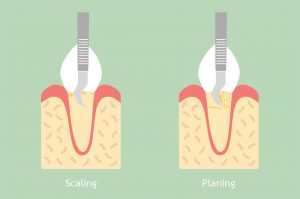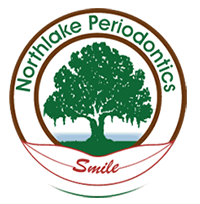SCALING AND ROOT PLANING
 The initial stage of treatment for periodontal disease might be a thorough, deep cleaning that may include scaling and/or root planing. The objective of these non-surgical procedures is to remove etiologic agents such as dental plaque and tartar, or calculus, which cause gingival inflammation and disease. Scaling and root planing can be used as a stand alone treatment or a preventative measure. They are commonly performed on cases of gingivitis and moderate to severe periodontal disease.
The initial stage of treatment for periodontal disease might be a thorough, deep cleaning that may include scaling and/or root planing. The objective of these non-surgical procedures is to remove etiologic agents such as dental plaque and tartar, or calculus, which cause gingival inflammation and disease. Scaling and root planing can be used as a stand alone treatment or a preventative measure. They are commonly performed on cases of gingivitis and moderate to severe periodontal disease.
What do the procedures entail?
Dr. LaSalle or her hygienist will only perform scaling and root planing after a thorough examination of the mouth, which may include taking x-rays, and visually examining the mouth. Depending on the condition of the gums, the amount of tartar present, the depth of the pockets and the progression of periodontitis, Dr. LaSalle may recommend scaling and root planing. In some cases, a local anesthesia may be used during the procedure.
Scaling
Scaling is instrumentation of the crown and root surfaces of the teeth to remove plaque and calculus from these surfaces.
Root Planing
- Root Planing is designed to remove cementum or surface dentin that is rough, impregnated with calculus, or contaminated with toxins or microorganisms, to smooth root surfaces below the gum line. This procedure utilizes very fine instruments to reach as deep as possible.
When deep pockets between teeth and gums are present, it is difficult for Dr. LaSalle to thoroughly remove plaque and tartar. Patients can seldom, if ever, keep these pockets clean and free of plaque. Consequently, surgery may be needed to restore periodontal health.
Benefits of Treatment
If treatment is successful, scaling and root planing has many periodontal benefits.The objective of these procedures is to remove irritants to permit shrinkage of swollen, inflamed gum tissue which may reduce pocket depth.
Research has proven that bacteria from periodontal infections travels through the blood stream and affects other areas of the body, sometimes causing heart and respiratory diseases. Scaling and root planing removes bacteria that cause these conditions.
Another benefit of treatment is protecting teeth against tooth loss. When gum pockets exceed 3mm in depth, the risk for periodontal disease increases. As pockets deepen, more bacteria are able to colonize, eventually causing a chronic inflammatory response by the body to destroy gingiva and bone tissue. This leads to tooth loss.
 The initial stage of treatment for periodontal disease might be a thorough, deep cleaning that may include scaling and/or root planing. The objective of these non-surgical procedures is to remove etiologic agents such as dental plaque and tartar, or calculus, which cause gingival inflammation and disease. Scaling and root planing can be used as a stand alone treatment or a preventative measure. They are commonly performed on cases of gingivitis and moderate to severe periodontal disease.
The initial stage of treatment for periodontal disease might be a thorough, deep cleaning that may include scaling and/or root planing. The objective of these non-surgical procedures is to remove etiologic agents such as dental plaque and tartar, or calculus, which cause gingival inflammation and disease. Scaling and root planing can be used as a stand alone treatment or a preventative measure. They are commonly performed on cases of gingivitis and moderate to severe periodontal disease.
What do the procedures entail?
Dr. LaSalle or her hygienist will only perform scaling and root planing after a thorough examination of the mouth, which may include taking x-rays, and visually examining the mouth. Depending on the condition of the gums, the amount of tartar present, the depth of the pockets and the progression of periodontitis, Dr. LaSalle may recommend scaling and root planing. In some cases, a local anesthesia may be used during the procedure.
Scaling
Scaling is instrumentation of the crown and root surfaces of the teeth to remove plaque and calculus from these surfaces.
Root Planing
- Root Planing is designed to remove cementum or surface dentin that is rough, impregnated with calculus, or contaminated with toxins or microorganisms, to smooth root surfaces below the gum line. This procedure utilizes very fine instruments to reach as deep as possible.
When deep pockets between teeth and gums are present, it is difficult for Dr. LaSalle to thoroughly remove plaque and tartar. Patients can seldom, if ever, keep these pockets clean and free of plaque. Consequently, surgery may be needed to restore periodontal health.
Benefits of Treatment
If treatment is successful, scaling and root planing has many periodontal benefits.The objective of these procedures is to remove irritants to permit shrinkage of swollen, inflamed gum tissue which may reduce pocket depth.
Research has proven that bacteria from periodontal infections travels through the blood stream and affects other areas of the body, sometimes causing heart and respiratory diseases. Scaling and root planing removes bacteria that cause these conditions.
Another benefit of treatment is protecting teeth against tooth loss. When gum pockets exceed 3mm in depth, the risk for periodontal disease increases. As pockets deepen, more bacteria are able to colonize, eventually causing a chronic inflammatory response by the body to destroy gingiva and bone tissue. This leads to tooth loss.
